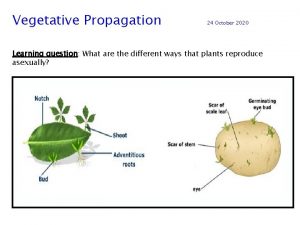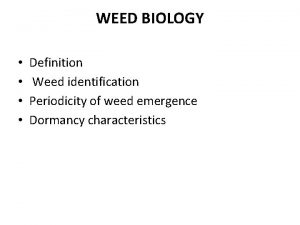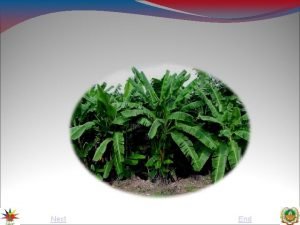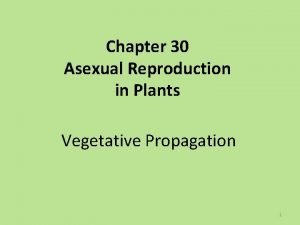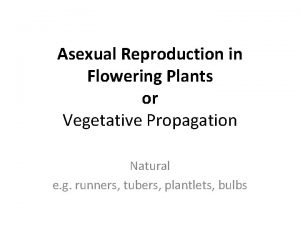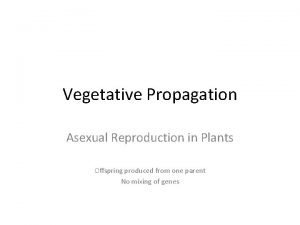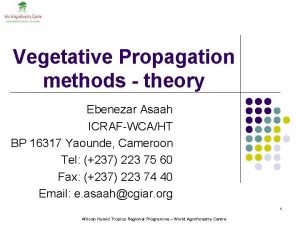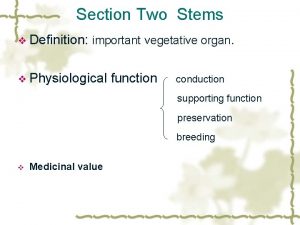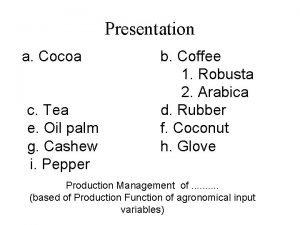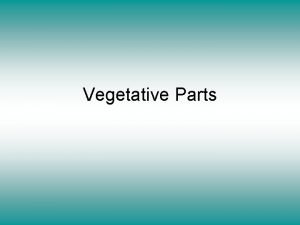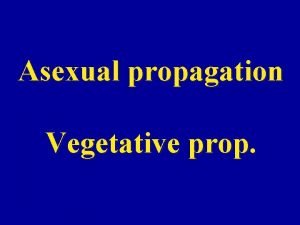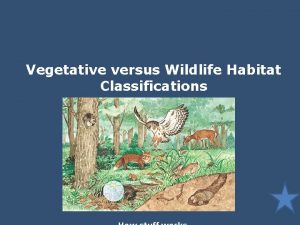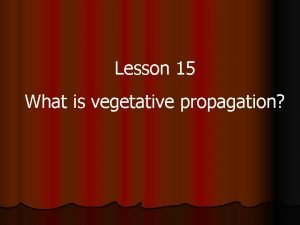Growing Plants Vegetative Propagation Propagation Process of increasing








- Slides: 8

Growing Plants Vegetative Propagation

Propagation Process of increasing the supply of a type of plant v Can be done sexually (using seeds) v - plants developed are non-identical v Can also be done asexually v - plants that develop are identical v - can be done naturally – using natural structures (e. g. bulbs) v - or artificially – e. g cuttings v

Natural propagation structures v v v v Bulbs - made of many leaf bases attached to a stem - swollen with stored food - side buds found in between the leaf bases - these develop into daughter bulbs - spring flowering bulbs can be re-planted in autumn - many bulbs (e. g. daffodil) make daughter bulbs naturally Tubers - swollen part of the stem or root – for food storage - each tuber can grow into a new plant if re-planted -e. g. potato plants form tubers on underground stems - ‘eyes’ form new shoots v - use food stored inside the tuber to help grow - tubers kept in a cool room (6 weeks) before re-planting - this is sprouting or chitting

Use of attached offspring v v v Plantlet - tiny plant still attached to parent - often develop at the leaves - e. g. Mexican Hat plant, Piggy Back plant Runner - plantlets at end of ‘horizontal’ stems - e. g. spider plant, strawberry plant Offsets - plantlet that develops at the base of the parent - these can be cut away from parent & replanted E. g mother-in-laws tongue

Artificial Propagation Increasing plant supply, using non-natural methods v Plant growth takes place at growth points e. g root tips, buds v Also at nodes – part of stem where side branches grow v If plant is wounded, it can regrow and replace missing parts v Parts of plants can be cut off and re-planted v

Cuttings Piece of plant cut, and re-planted v Roots grow from cut surface v Cut end needs planting in moist soil or in water v Rooting powder can help root growth v Cuttings can lose water through their leaves v Water loss can be reduced by v - trimming off lower leaves on cutting v - placing cutting in a propagator/plastic bag v

Heat during propagation Heating systems/propagators keep constant temperatures v Encourages cuttings to root v Useful in colder months of the year, BUT v - too high a temperature will cause water loss v - too moist (humid) an atmosphere helps spread disease v - heating costs can be high v A thermostat controlled system is best v

Layering A stem is made to root whilst attached to parent v A cut is made into stem, just below a node v Rooting powder applied to this ‘wound’ v Rest of plant pegged in place until new roots grow v Then new plant is cut away from parent v Effective for plants that don’t grow well with cuttings v
